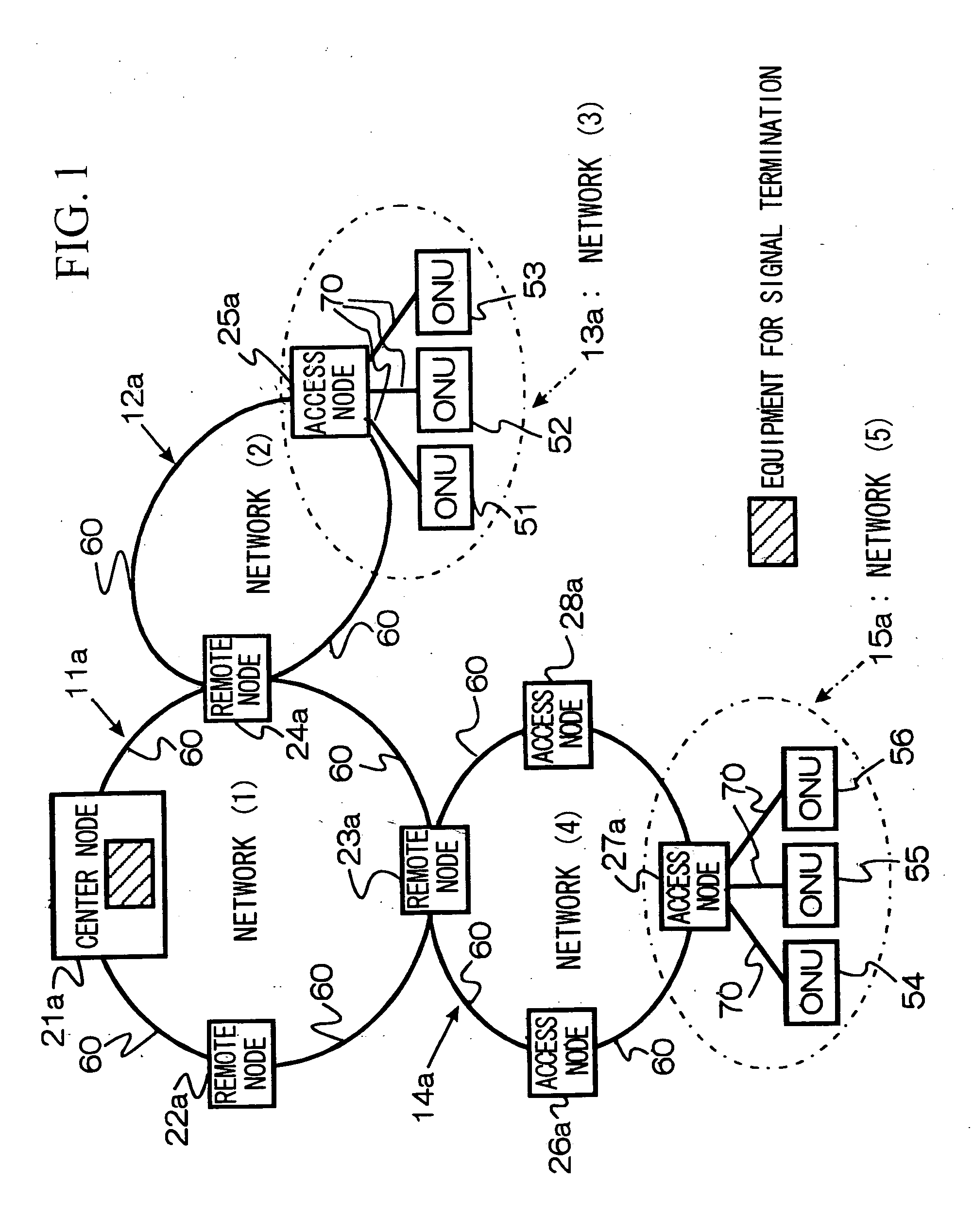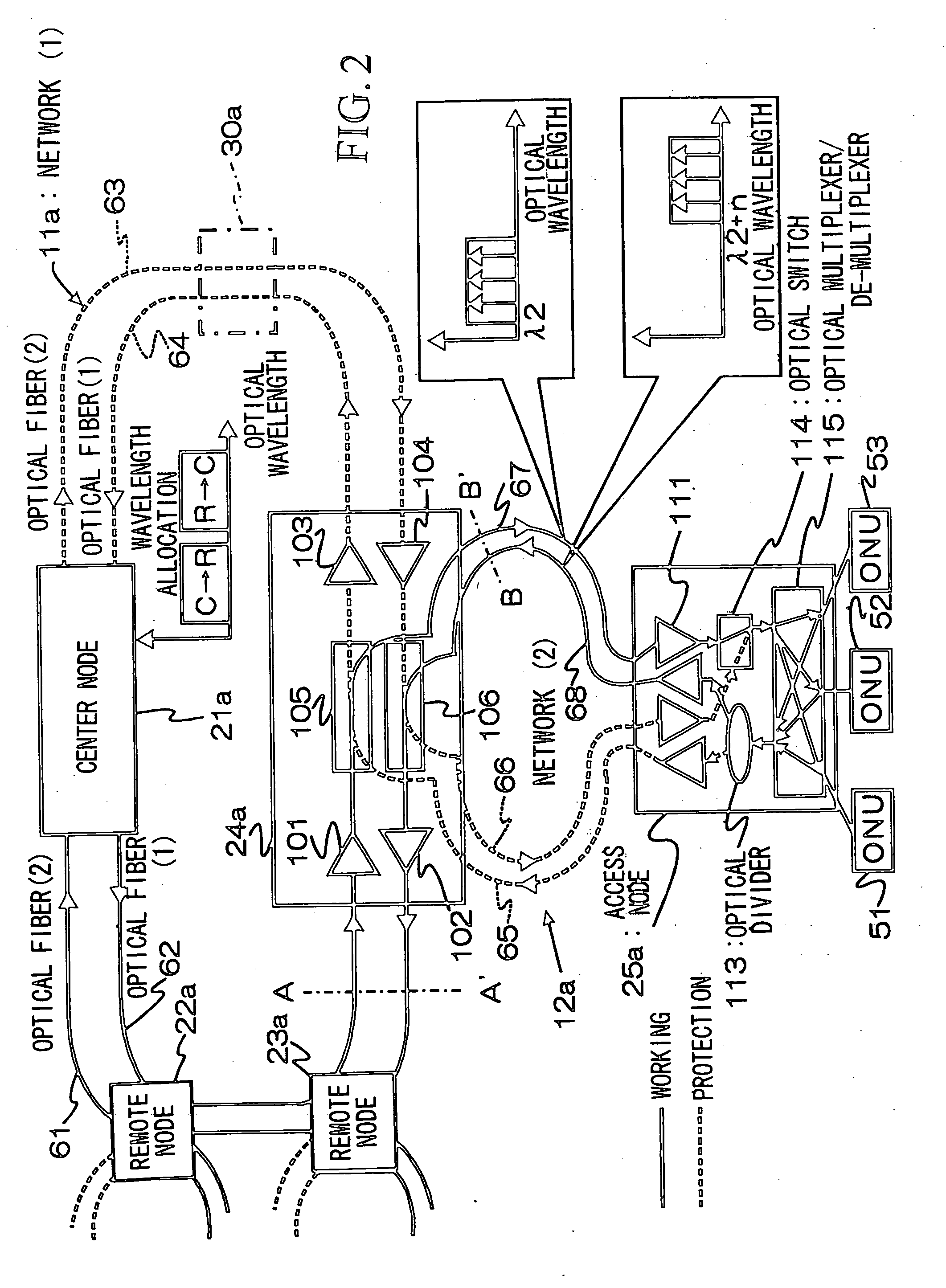Node apparatus, optical wavelength division multiplexing network, and system switching method
a technology of optical wavelength division and node apparatus, applied in loop networks, multiplex communication, instruments, etc., can solve the problems of drawbacks of expenditure efficiency and considerable initial expenditure, and achieve the effect of reducing initial expenditure and simplifying the constitution
- Summary
- Abstract
- Description
- Claims
- Application Information
AI Technical Summary
Benefits of technology
Problems solved by technology
Method used
Image
Examples
embodiment 1
[0063]FIG. 1 is a block diagram showing the entire constitution of the optical wavelength division multiplexing network in this embodiment and in embodiments subsequently explained. As shown in FIG. 1, parts of the constitution which are identical to those in FIG. 25 are represented by the same reference numerals. Parts of the constitution which correspond to those in FIG. 25 are specified by adding the letter “a” to the end of the reference numerals shown in FIG. 25.
[0064] The first embodiment will be explained with reference to FIGS. 1 and 2. FIG. 2 is a block diagram showing the constitutions of the network (1) 11a, the network (2) 12a, and the network (3) 13a, shown in FIG. 1. This embodiment uses a two-fiber bi-directional ring constitution, in which the nodes of the networks (1) 11a, (2) 12a, etc., are connected by pairs of optical fibers which transmit optical signals in differing directions. For example, in the network (1) 11a, the nodes are connected by optical fibers (1) ...
embodiment 2
[0080]FIG. 3 shows an embodiment comprising a double ring. This embodiment differs from that shown in FIG. 2 in that (i) a plurality of access nodes are connected to the remote node, (ii) the access nodes are connected in a ring, and particularly (iii) this embodiment comprises an optical band pass filter which prevents optical signals at the wavelengths allocated to the ONU 54, 55, and 56, which belong to the ring network (4) 14a comprising the remote node 23a, from passing around the ring network. An optical band pass filter 301 which passes only wavelengths allocated for transmission from the remote node 23a to the center node 21a, and optical band pass filter 302 which passes only wavelengths allocated for transmission from the center node 21a to the remote node 23a, are connected to the input and output terminals of the optical coupler 105 in the remote node 23a. In addition, the optical band pass filters 301 and 302 are connected to the input and output terminals of an optical...
embodiment 3
[0083]FIG. 7 shows an embodiment comprising a two-fiber unidirectional ring. This embodiment is characterized in that the transmission direction of the optical signal from the center node 21a to the remote node 24b (corresponding to the remote node 24a of FIG. 2) is the same as the transmission direction of the optical signal from the remote node 24b to the center node 21a. FIG. 7 shows the constitution of the remote node 24b and the access node 25a at this time. This constitution differs from that shown in FIG. 2 in that the up and down signals from the access node 25a are input to identical optical couplers 105b and 106b, provided at the remote node 24b. The optical fibers 67b and 68b (corresponding to the optical fibers 67 and 68 of FIG. 2) are connected to the optical coupler 105b, and the optical fibers 65b and 66b (corresponding to the optical fibers 65 and 66 of FIG. 2) are connected to the optical coupler 106b. Here, the network (1) 11b comprising the center node 21a is arra...
PUM
 Login to View More
Login to View More Abstract
Description
Claims
Application Information
 Login to View More
Login to View More - R&D
- Intellectual Property
- Life Sciences
- Materials
- Tech Scout
- Unparalleled Data Quality
- Higher Quality Content
- 60% Fewer Hallucinations
Browse by: Latest US Patents, China's latest patents, Technical Efficacy Thesaurus, Application Domain, Technology Topic, Popular Technical Reports.
© 2025 PatSnap. All rights reserved.Legal|Privacy policy|Modern Slavery Act Transparency Statement|Sitemap|About US| Contact US: help@patsnap.com



